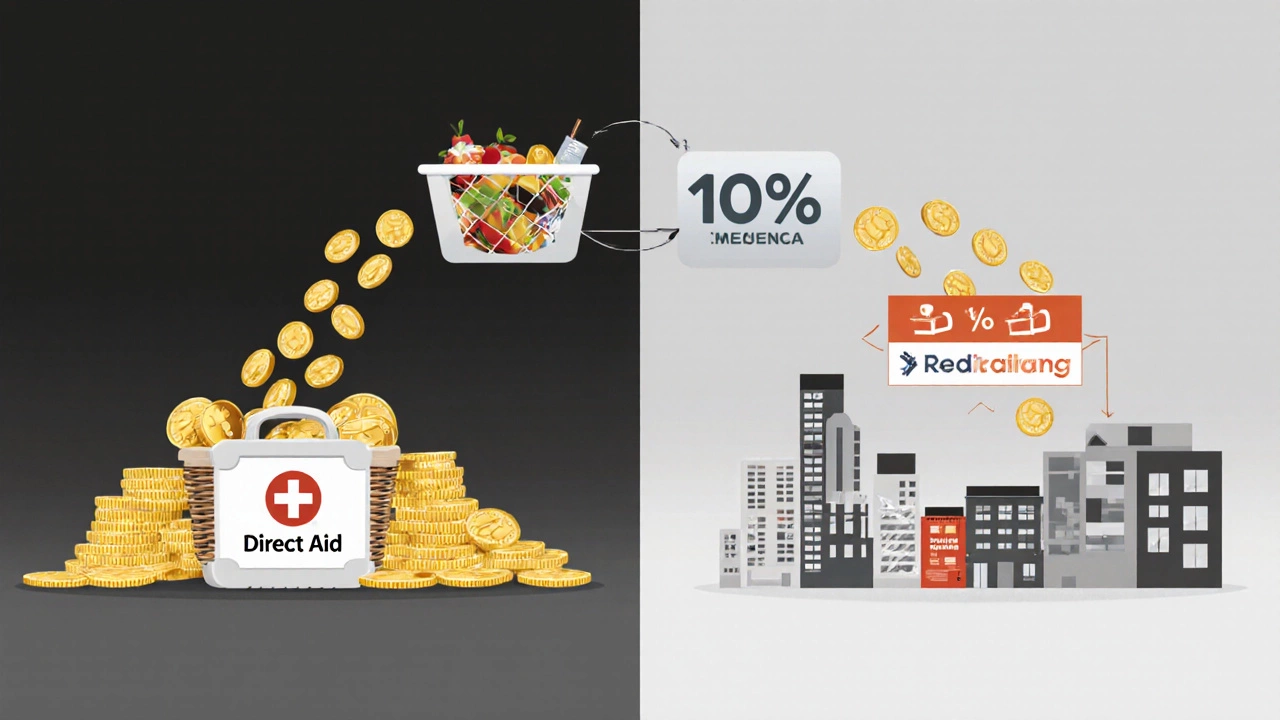Charity Donation Impact Calculator
See how much of your donation actually reaches those in need. Many charities spend 25-40% on administration and fundraising. Adjust the percentage to see the real impact of your gift.
Select what percentage goes to direct programs (70-90% is considered good)
£85.00
£15.00
Strong impact - Charity spends 85% of donations directly on programs
When you donate to a charity-whether it’s a bake sale, a walkathon, or a televised appeal-you want to believe your money is helping people in need. But how much of it actually gets there? The answer isn’t as simple as it sounds. Many people assume most donations go straight to the cause. The truth? It’s messy, uneven, and often hidden behind polished marketing.
What happens to your donation? The breakdown
Charities don’t just take your cash and hand it out. There are costs. Salaries. Office rent. Website hosting. Fundraising campaigns. Legal compliance. These aren’t luxuries-they’re necessities. But here’s the problem: not all charities manage them the same way.
According to data from the Charity Commission for England and Wales, the average charity spends about 75% of its income on programs and services. That means roughly 25% goes to administration and fundraising. Sounds reasonable? Maybe. But that average hides huge gaps.
Some charities spend 90% or more on direct aid. Others? Less than 60%. A 2023 audit by the Charity Finance Group found that 1 in 5 UK charities spent more on fundraising than they raised in new donations. That’s not efficiency-that’s a loop.
Take a local food bank. Most of your donation likely goes to buying bread, milk, and beans. Rent for their warehouse? Maybe. A van to deliver meals? Yes. But if that same food bank runs a glossy TV ad campaign costing £50,000 to raise £100,000, you’re paying for the ad, not the food.
Why do charities spend so much on fundraising?
It’s not because they’re wasteful-it’s because they’re competing. There are over 160,000 registered charities in the UK. They’re all asking for the same money. So they invest in ads, celebrity endorsements, direct mail, and social media influencers to stand out.
Some charities use donor acquisition as a strategy. They spend £1 to raise £3, banking on the fact that the person will give again next year. That’s not bad if it works. But if the donor never gives again? You’ve spent £1 to get nothing long-term.
And then there’s the overhead myth. People panic when they see a charity spends £10,000 on an accountant. But without proper financial controls, fraud can slip through. In 2022, a Scottish charity was shut down after £200,000 in donations vanished. The audit found no payroll, no bank records, no receipts. Proper administration isn’t a cost-it’s a shield.
What counts as "program spending"?
Not everything that sounds like "helping people" actually is. Charities can count things like advocacy, public awareness campaigns, or even lobbying as program expenses. A charity fighting climate change might say their campaign to ban plastic straws is "program work." But if you donated to help homeless families, does that count as your money helping them?
The Charity Navigator system in the US and the Charity Commission in the UK both require charities to report spending by category. But the categories are broad. "Program services" can include anything from emergency shelters to policy research. That’s why two charities with identical missions can look wildly different on paper.
One animal rescue group spends 85% on vet bills. Another spends 80% on social media ads to promote adoption events. Both are helping animals. But which one is more efficient? It depends on your goal.

How to tell if a charity is worth your money
You don’t need a finance degree to check if your donation matters. Here’s how to do it in five minutes:
- Visit the charity’s website and look for their annual report or financial statements. They’re legally required to publish them.
- Find the "Income and Expenditure" table. Look for "Charitable Activities" or "Program Expenses." That’s your target number.
- Subtract that from total income. What’s left? That’s fundraising and admin.
- Ask: Is the fundraising cost sustainable? If they spent £50,000 to raise £60,000, that’s okay. If they spent £80,000 to raise £60,000? Red flag.
- Check if they list outcomes. "We fed 2,000 families" is better than "We’re making a difference."
Use tools like Charity Commission’s Register of Charities or GuideStar (UK version: Charity Commission for Scotland or Charity Commission for Northern Ireland) to see audited accounts. You don’t need to dig deep-just scan the top numbers.
The high performers: who gets it right?
Some charities are transparent, lean, and effective. The British Red Cross spends 89% of every pound on direct aid. The Scottish Food Train, which delivers meals to isolated elderly people, spends 92%. The St. Mungo’s charity for homelessness spends 87% on services.
These aren’t outliers. They’re intentional. They avoid flashy campaigns. They use volunteers. They partner with local councils. They don’t need to scream to be heard.
Compare that to some national charities that spend 40% or more on fundraising. Their ads are everywhere. Their logos are on billboards. But their actual impact? Hard to measure. And often, their donor retention rates are terrible. People give once, then never hear from them again.
What about charity events? Are they worth it?
Community bake sales, fun runs, and school auctions feel personal. You know the person running the stall. That’s powerful. But here’s the catch: event-based fundraising often has high costs. Venue hire, permits, insurance, printed materials, volunteers’ snacks, and marketing can eat up 50-70% of the money raised.
That doesn’t mean you shouldn’t participate. It means you should ask: Who benefits? If your school’s bake sale raises £500 for a local homeless shelter, and the shelter uses every penny for meals, then yes-it’s worth it. But if the event is run by a national charity that takes 60% for "central coordination," you’re not helping as much as you think.
Local events with local beneficiaries? Often the most efficient. National events with big overhead? Less so.

Transparency isn’t optional-it’s the new standard
Donors today aren’t just giving money. They’re demanding trust. And the charities that survive are the ones that answer the hard questions.
Some now publish real-time dashboards showing exactly where each donation goes. "£25 bought 100 meals for children." "£50 paid for a week of counselling." Others publish photos of recipients with consent. That’s not marketing-it’s accountability.
When you donate, you’re not just giving cash. You’re voting. You’re saying, "I trust this organization to use my money well." If you don’t know how they use it, you’re voting blind.
What you can do right now
Don’t stop giving. But start giving smarter.
- Support local charities with clear spending reports.
- Ask: "What percentage of my donation goes directly to people in need?" Don’t be shy.
- Give monthly, not just during holiday drives. Steady funding lets charities plan better and cut overhead.
- If you’re unsure, donate to a charity you already know-your local food bank, your neighborhood shelter, your church’s outreach team. You can see their work.
- Volunteer. Time often has more impact than money.
Charities aren’t villains. Many are run by people who care deeply. But the system is broken in places. And the only way to fix it is by asking the questions no one wants to answer.
Next time you hand over cash or click "Donate," pause. Ask: Where is this going? The answer might surprise you.
What percentage of charity donations should go to programs?
There’s no universal rule, but experts generally agree that 70% or more of donations should go directly to programs and services. Top-performing charities often reach 80-90%. Anything below 60% raises red flags, especially if fundraising costs are high. The key is sustainability-charities need some overhead to operate, but excessive spending on admin or marketing means less help for those in need.
Are charity events like fun runs and bake sales worth it?
It depends. Local events with low overhead and direct local beneficiaries often have high impact-up to 80% of funds can reach the cause. But if the event is organized by a national charity with expensive logistics, marketing, and central fees, only 30-50% may go to the cause. Always ask how the money is split. If the organizer won’t say, that’s a sign to dig deeper.
How do I check if a charity is legitimate?
In the UK, all registered charities must be listed on the Charity Commission website (for England and Wales), the Office of the Scottish Charity Regulator (OSCR), or the Charity Commission for Northern Ireland. Search the charity’s name there. Look for published annual reports and financial statements. If they don’t have them, avoid donating. Also, check if they’ve been flagged for misconduct-some charities are removed for fraud or mismanagement.
Do charities pay their staff too much?
Some do, some don’t. Large charities need skilled professionals-accountants, project managers, fundraisers-to run effectively. A CEO of a national charity might earn £80,000-£150,000, which sounds high, but it’s often comparable to similar roles in the public or nonprofit sector. The issue isn’t salary alone-it’s whether the salary is justified by results. A £100,000 salary is fine if the charity raised £5 million and helped 10,000 people. It’s not if they raised £200,000 and barely moved the needle.
Can I donate my time instead of money?
Absolutely-and sometimes it’s more valuable. Many charities struggle with volunteer capacity more than funding. Helping sort food at a pantry, driving someone to a doctor’s appointment, or tutoring a child can have a direct, lasting impact. Time doesn’t get eaten up by overhead. And volunteering often gives you a clearer view of how the charity really operates.
Final thought: Trust, but verify
Charities do good work. But good intentions don’t guarantee good results. The most effective charities aren’t the loudest-they’re the most honest. They show you the numbers. They admit what they can’t fix. They let you see the people they help.
Your donation matters. But only if you know where it’s going. Don’t assume. Don’t guess. Ask. Look. Decide. That’s how you make sure your kindness actually changes lives-not just fills a budget line.
